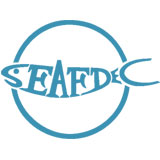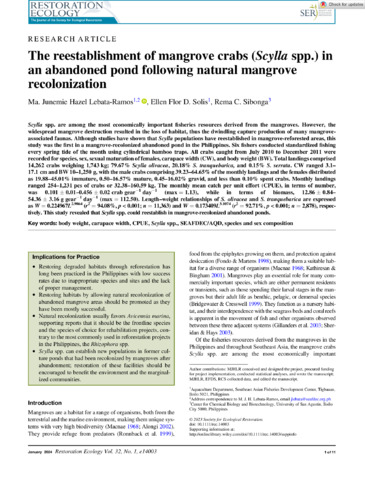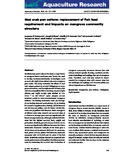Ipakita ang simpleng tala ng item
Pen culture of mud crab Scylla serrata in tidal flats reforested with mangrove trees
Share
| dc.contributor.author | Triño, Avelino T. | |
| dc.contributor.author | Rodriguez, Eduard M. | |
| dc.date.accessioned | 2014-03-25T04:02:20Z | |
| dc.date.available | 2014-03-25T04:02:20Z | |
| dc.date.issued | 2002 | |
| dc.identifier.citation | Triño, A. T., & Rodriguez, E. M. (2002). Pen culture of mud crab Scylla serrata in tidal flats reforested with mangrove trees. Aquaculture, 211(1-4), 125-134. | en |
| dc.identifier.issn | 0044-8486 | |
| dc.identifier.uri | http://hdl.handle.net/10862/1950 | |
| dc.description.abstract | Growth and survival of mixed sex mud crabs Scylla serrata (Forskal), held in 200 m2 pens located in reforested mangrove tidal flats, were evaluated. The effects of stocking density (0.5 or 1.5 m−2) and feed (salted fish bycatch or a mixed diet of 75% salted brown mussel flesh and 25% salted fish bycatch) were determined in a replicated factorial experiment. Duration of the experiment was 160 days. There were no significant differences (P>0.05) in growth, apparent feed conversion ratio (FCR), survival, and production among the two types of feed. Regardless of feed, the mean±SE FCR of 5.30±0.34 and survival of 56.00±1.90% at 0.5 m−2 stocking density were significantly better (P<0.05) than at 1.5 m−2 stocking density (7.6±0.63 FCR and 33.00±3.61% survival). However, growth was not significantly affected by stocking density. Cost–return analysis on a per crop per 200 m2 basis showed that the use of either of the two stocking densities with either diet was economically viable with a return on capital investment of 49–68%. However, crabs stocked at 1.5 m−2 and fed a mixed diet of 75% salted brown mussel flesh and 25% salted fish bycatch is more profitable. The integration of crab aquaculture within natural mangroves is therefore feasible in the Philippines, providing both immediate and long-term commercial and environmental benefits. | en |
| dc.language.iso | en | en |
| dc.publisher | Elsevier | en |
| dc.subject | Scylla serrata | en |
| dc.subject | Philippines | en |
| dc.subject | Aquasilviculture | en |
| dc.subject | Mud crab | en |
| dc.title | Pen culture of mud crab Scylla serrata in tidal flats reforested with mangrove trees | en |
| dc.type | Article | en |
| dc.citation.volume | 211 | |
| dc.citation.issue | 1-4 | |
| dc.citation.spage | 125 | |
| dc.citation.epage | 134 | |
| dc.citation.journalTitle | Aquaculture | en |
| dc.subject.asfa | cage culture | en |
| dc.subject.asfa | crab culture | en |
| dc.subject.asfa | feeding experiments | en |
| dc.subject.asfa | growth rate | en |
| dc.subject.asfa | mangrove swamps | en |
| dc.subject.asfa | reclamation | en |
| dc.subject.asfa | stocking density | en |
| dc.subject.asfa | survival | en |
| dc.subject.asfa | tidal flats | en |
| dc.subject.asfa | economics | en |
| dc.subject.asfa | mangroves | en |
| dc.identifier.doi | 10.1016/S0044-8486(01)00890-0 | |
| dc.subject.scientificName | Scylla serrata | en |
Mga file sa item na ito
| Mga file | Sukat | Format | Tingnan |
|---|
Lumilitaw ang item na ito sa sumusunod na (mga) Koleksyon
-
AQD Journal Articles [1223]
These papers were contributed by AQD staff to various national and international journals



